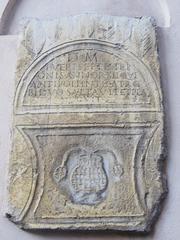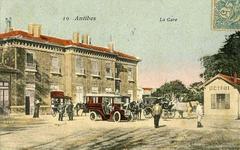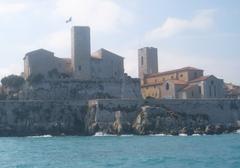
शैतो साले एंटीब्स: संपूर्ण विजिटिंग घंटे, टिकट और यात्रा गाइड
तिथि: 03/07/2025
परिचय: एंटीब्स में शैतो साले क्यों जाएं?
फ्रांसीसी रिवेरा पर धूप में नहाए एंटीब्स के केंद्र में स्थित, शैतो साले इस क्षेत्र के बहुस्तरीय इतिहास, वास्तुशिल्प भव्यता और जीवंत सांस्कृतिक जीवन का प्रतीक है। सॉल्ट कैसल के रूप में जाना जाने वाला यह स्थल सदियों से एक रणनीतिक किला, कर संग्राहक का निवास, जेल, सैन्य बैरक और अब एक संग्रहालय के रूप में कार्य करता रहा है - यह एंटीब्स की सदियों से अनुकूलन करने की क्षमता का प्रमाण है। इसकी कहानी ग्रिमाल्डी परिवार की विरासत, नमक कर के युग, नेपोलियन बोनापार्ट के प्रभाव और पाब्लो पिकासो के निवास से शुरू हुई कलात्मक क्रांति के साथ जुड़ी हुई है। आज, शैतो साले आगंतुकों को इसके प्रभावशाली प्राचीरों, ऐतिहासिक कक्षों और क्यूरेटेड प्रदर्शनियों का पता लगाने के लिए आमंत्रित करता है, साथ ही भूमध्य सागर के मनोरम दृश्यों का भी आनंद लेने का अवसर देता है।
वर्तमान आगंतुक जानकारी, टिकट और सांस्कृतिक कार्यक्रमों के लिए, म्यूसी पिकासो वेबसाइट और एंटीब्स पर्यटन कार्यालय (फ्रेंच लेसन ब्लॉग, किर्स्टी विल ट्रैवल) से परामर्श करें।
सामग्री
- ऐतिहासिक अवलोकन: उत्पत्ति से आधुनिक युग तक
- वास्तुकला: मध्ययुगीन नींव से पुनर्जागरण काल की भव्यता तक
- आज का शैतो साले: संग्रहालय और सांस्कृतिक स्थल
- आगंतुक जानकारी: घंटे, टिकट और सुझाव
- पहुंच और निर्देशित पर्यटन
- आस-पास के आकर्षण
- अक्सर पूछे जाने वाले प्रश्न
- अपनी यात्रा की योजना बनाएं: व्यावहारिक सिफारिशें
- स्रोत
ऐतिहासिक अवलोकन: उत्पत्ति से आधुनिक युग तक
प्राचीन जड़ें और मध्ययुगीन शक्ति
शैतो साले का इतिहास 5वीं शताब्दी ईसा पूर्व तक जाता है, जब एंटीब्स (तब एंटीपोलिस) को एक ग्रीक चौकी के रूप में स्थापित किया गया था (फ्रेंच लेसन ब्लॉग)। यह स्थल रोमन प्रभाव में विकसित हुआ और मध्य युग तक, यह क्षेत्रीय रक्षा और शासन का एक महत्वपूर्ण केंद्र बन गया। इसका समुद्र तटीय स्थान इसे एक महत्वपूर्ण सैन्य गढ़ बनाता था, जिस पर अक्सर सामंती प्रभुओं, चर्च और विदेशी शक्तियों द्वारा दावा किया जाता था।
ग्रिमाल्डी राजवंश
14वीं शताब्दी के उत्तरार्ध में, शक्तिशाली जेनोइस कुलीन ग्रिमाल्डी परिवार ने एंटीब्स और उसके महल पर अपना शासन सुरक्षित कर लिया, जैसा कि हाल ही में फ्रांस वापस लाए गए मध्ययुगीन चर्मपत्रों में दर्ज है (फ्रेंच लेसन ब्लॉग)। मार्क और ल्यूक डी ग्रिमाल्डी को पोप के विरोधी क्लेमेंट VII से महल प्राप्त हुआ, जिसने पोप और राजनीतिक उथल-पुथल के दौर में उनके अधिकार को मजबूत किया।
शाही और क्रांतिकारी युग
1608 में हेनरी चतुर्थ के अधीन महल फ्रांसीसी शाही नियंत्रण में आया, बाद में यह शाही गवर्नर के निवास, टाउन हॉल और सैन्य बैरक के रूप में कार्य करता रहा। “साले” नाम गैबेल, शाही नमक कर का संदर्भ देता है जो शैतो से प्रशासित होता था (nicematin.com)। 18वीं शताब्दी के उत्तरार्ध में, बोनापार्ट परिवार संक्षेप में यहां रहा, और शैतो को नेपोलियन युग में एक जेल के रूप में इस्तेमाल किया गया (cityzeum.com)।
20वीं शताब्दी: संरक्षण और पिकासो
1925 में शहर द्वारा अधिग्रहित, शैतो साले एक संग्रहालय बन गया, और द्वितीय विश्व युद्ध के बाद, पाब्लो पिकासो को कलाकार-इन-निवास के रूप में होस्ट किया। उनके कार्यों को अब पिकासो संग्रहालय का मुख्य आकर्षण माना जाता है, जो शैतो की निरंतर सांस्कृतिक प्रासंगिकता सुनिश्चित करता है (फ्रेंच लेसन ब्लॉग)।
वास्तुकला: मध्ययुगीन नींव से पुनर्जागरण काल की भव्यता तक
रक्षात्मक उत्पत्ति
प्राचीन किलों के ऊपर निर्मित, शैतो साले में मोटी चूना पत्थर और ईंट की दीवारें, युद्धकपोत और तीर के छेद हैं - जो प्रोवेन्सल सैन्य वास्तुकला की पहचान हैं (kirstiewilltravel.com)। 16वीं शताब्दी के चार विशिष्ट गोल टावरों ने महल की रक्षात्मक क्षमताओं को मजबूत किया।
पुनर्जागरण और बाद के अनुकूलन
शैतो ने महत्वपूर्ण पुनर्जागरण काल के संशोधन देखे: तोपों के लिए टावरों को मजबूत किया गया, बुर्ज जोड़े गए, और प्रकाश और सौंदर्यशास्त्र के लिए पत्थर की खिड़कियां पेश की गईं। मध्ययुगीन चिनाई और पुनर्जागरण काल की बारीकियों का यह सह-अस्तित्व उसके अनूठे वास्तुशिल्प चरित्र को परिभाषित करता है।
आंतरिक स्थान
अंदर, वाल्टेड कक्ष, भंडारण कक्ष और आवासीय क्वार्टर एक केंद्रीय आंगन के चारों ओर फैले हुए हैं। सजावटी प्लास्टरवर्क, भित्ति चित्र और कालानुक्रमिक फायरप्लेस इसके पूर्व निवासियों के जीवन को दर्शाते हैं। बाद की सदियों में प्रशासनिक कार्यालयों और सैन्य प्रतिष्ठानों को जोड़ा गया।
आज का शैतो साले: संग्रहालय और सांस्कृतिक स्थल
अब म्यूसी नेपोलियनियन का घर, शैतो साले नेपोलियन और स्थानीय इतिहास से संबंधित कलाकृतियों को प्रदर्शित करता है (cityzeum.com)। आसन्न शैतो ग्रिमाल्डी में स्थित पिकासो संग्रहालय, पिकासो के निवास के दौरान बनाए गए कार्यों को प्रदर्शित करता है (सी एंटीब्स)। बहाली के प्रयासों ने स्थल की ऐतिहासिक अखंडता को संरक्षित किया है, साथ ही आगंतुकों के लिए आधुनिक सुविधाएं भी एकीकृत की हैं (nicematin.com)।
आगंतुक जानकारी: घंटे, टिकट और सुझाव
- खुलने के दिन: मंगलवार से रविवार (सोमवार और चुनिंदा छुट्टियों को बंद)
- घंटे: सुबह 10:00 बजे - शाम 6:00 बजे (अंतिम प्रवेश 5:30 बजे)
- टिकट मूल्य: वयस्क €7, रियायती €4 (छात्र/वरिष्ठ), 12 वर्ष से कम उम्र के बच्चे मुफ्त
- कहां से खरीदें: संग्रहालय के प्रवेश द्वार पर या एंटीब्स पर्यटन वेबसाइट के माध्यम से ऑनलाइन।
- निर्देशित पर्यटन: सप्ताहांत पर और अपॉइंटमेंट द्वारा; फ्रेंच में उपलब्ध, उच्च सीजन में अंग्रेजी पर्यटन उपलब्ध।
नवीनतम अपडेट के लिए, अपनी यात्रा से पहले हमेशा आधिकारिक एंटीब्स पर्यटन कार्यालय देखें।
पहुंच और निर्देशित पर्यटन
जबकि संग्रहालय क्षेत्र व्हीलचेयर-सुगम हैं, कुछ ऐतिहासिक क्षेत्र (टावर, प्राचीर) सीढ़ियों और असमान फर्श के कारण चुनौतियां पेश कर सकते हैं। आवासों पर चर्चा करने के लिए यात्रा से पहले संग्रहालय से संपर्क करने की सलाह दी जाती है। निर्देशित पर्यटन गहन ऐतिहासिक और वास्तुशिल्प संदर्भ प्रदान करते हैं, जिसमें अग्रिम बुकिंग की सिफारिश की जाती है, खासकर अंग्रेजी भाषा के पर्यटन के लिए (ट्रैवल पैंडर)।
आस-पास के आकर्षण
अपनी यात्रा को बढ़ाने के लिए अन्वेषण करें:
- पिकासो संग्रहालय (शैतो ग्रिमाल्डी): पिकासो के एंटीब्स काल की उत्कृष्ट कृतियाँ (सी एंटीब्स)
- फोर्ट कैरे: मनोरम समुद्री दृश्यों वाला 16वीं शताब्दी का तटीय किला (पॉकेटवांडरिंग्स.कॉम)
- एंटीब्स कैथेड्रल: अपने ऐतिहासिक मुखौटे और लुई ब्रे वेदी के लिए प्रसिद्ध (ट्रैवल फ्रांस ब्लॉग)
- मार्शे प्रोवेन्सल और पोर्ट वैउबन: स्थानीय संस्कृति और पाक का अनुभव करें
अक्सर पूछे जाने वाले प्रश्न
प्र: शैतो साले के खुलने का समय क्या है? उ: मंगलवार से रविवार, सुबह 10:00 बजे से शाम 6:00 बजे तक। सोमवार और चुनिंदा छुट्टियों को बंद।
प्र: टिकट की कीमत क्या है? उ: वयस्कों के लिए €7, छात्रों/वरिष्ठों के लिए €4, 12 वर्ष से कम उम्र के बच्चे मुफ्त।
प्र: क्या शैतो विकलांग लोगों के लिए सुलभ है? उ: मुख्य संग्रहालय क्षेत्र सुलभ हैं, लेकिन कुछ ऐतिहासिक क्षेत्रों में सीढ़ियों और असमान फर्श के कारण पहुंच सीमित हो सकती है। विवरण के लिए पहले से संग्रहालय से संपर्क करें।
प्र: क्या निर्देशित पर्यटन उपलब्ध हैं? उ: हाँ - सप्ताहांत और अपॉइंटमेंट द्वारा। अंग्रेजी पर्यटन उच्च सीजन में उपलब्ध हैं।
प्र: क्या मैं अपनी यात्रा को एंटीब्स के अन्य स्थलों के साथ जोड़ सकता हूँ? उ: बिल्कुल - पिकासो संग्रहालय, फोर्ट कैरे, और पुराने शहर सभी आस-पास हैं।
अपनी यात्रा की योजना बनाएं: व्यावहारिक सिफारिशें
- पहुंच: शैतो पुराने शहर में है; पैदल पहुंचना सबसे अच्छा है। सार्वजनिक परिवहन और हॉप-ऑन-हॉप-ऑफ बसें पास में रुकती हैं।
- पार्किंग: शैतो के पास सीमित; पोर्ट वैउबन में सार्वजनिक पार्किंग उपलब्ध है।
- सबसे अच्छा समय: वसंत और पतझड़ में सुखद मौसम और कम भीड़ होती है।
- पोशाक: कोबलस्टोन और सीढ़ियों के लिए मजबूत जूते पहनें; धूप से बचाव लाएं।
- टिकट: भीड़ से बचने के लिए पीक सीजन में ऑनलाइन बुक करें।
- फोटोग्राफी: बाहर अनुमति है; अंदर की पाबंदियों के बारे में पूछें।
- परिवार के अनुकूल: निर्देशित पर्यटन सभी उम्र के लिए इतिहास को आकर्षक बनाते हैं।
- भोजन: अपनी यात्रा के बाद आस-पास के कैफे और प्रोवेन्सल भोजनालयों का अन्वेषण करें।
स्रोत
- फ्रेंच लेसन ब्लॉग: राजकुमार और पोप विरोधी
- किर्स्टी विल ट्रैवल: एंटीब्स में करने योग्य सर्वश्रेष्ठ कार्य
- सिटीज़ेम: म्यूसी नेपोलियनियन
- नाइस मार्टिन: एंटीब्स में छिपे हुए 6 महल
- कैप वॉयज: एंटीब्स की विरासत
- पर्यटक स्थल गाइड: एंटीब्स आकर्षण
- पॉकेट वांडरिंग्स: एंटीब्स में करने योग्य कार्य
- ट्रैवल फ्रांस ब्लॉग: एंटीब्स में करने योग्य सर्वश्रेष्ठ कार्य
- ट्रैवल पैंडर: फ्रांस में पिकासो संग्रहालय
- सी एंटीब्स: जुलाई में क्या है
अतिरिक्त यात्रा युक्तियों, विस्तृत गाइडों और अद्यतित सांस्कृतिक जानकारी के लिए, ऑडियला ऐप डाउनलोड करें और नवीनतम अपडेट के लिए सोशल मीडिया पर हमें फॉलो करें। आज ही एंटीब्स की समृद्ध विरासत की अपनी तल्लीन करने वाली यात्रा की योजना बनाएं!
ऑडियला2024{‘date’: ‘03/07/2025’, ‘task’: {‘model’: ‘gpt-4.1-mini’, ‘query’: ‘Comprehensive guide to visiting Château Salé, Antibes, Antibes, France: history, significance, visitor tips, and everything tourists need to know for a memorable experience.’, ‘verbose’: False, ‘guidelines’: [“Keyword Research: Identify relevant keywords that potential visitors are likely to search for, such as ‘[Monument Name] visiting hours,’ ‘[Monument Name] tickets,’ and ‘[City] historical sites.’ Use these keywords strategically throughout the article, including in the title, headers, and body text, but avoid keyword stuffing.”, ‘Engaging and Informative Title: Craft a title that is both SEO-friendly and compelling to encourage clicks. Include the main keyword and make it clear what the article will cover.’, ‘Structured Content: Use headings (H1, H2, H3) to organize the content effectively. This helps with SEO and makes the article easier for readers to navigate. Include an introduction that hooks the reader, a detailed body that covers all relevant aspects, and a conclusion that summarizes the key points.’, ‘Comprehensive Coverage: Address common questions and topics of interest such as the history of the monument, its cultural significance, visitor information (e.g., ticket prices, opening hours), travel tips, nearby attractions, and accessibility. Include sections that might be unique to the monument, like special events, guided tours, and photographic spots.’, ‘Quality Content: Ensure the content is well-researched, accurate, and provides real value to readers. Use reliable sources and provide factual information. Write in a clear, engaging, and accessible style. Consider your audience and use language that is appropriate for those likely to visit the monument.’, ‘Visuals and Media: Incorporate high-quality images or videos of the monument. These should be optimized for the web (correct sizing, alt tags with keywords). Consider interactive elements like virtual tours or maps.’, ‘Internal and External Links: Include links to other related articles on your site to encourage deeper engagement (internal links). Link to official websites for the monument or credible sources for further reading (external links).’, ‘FAQ: Incorporate FAQ sections to target voice search queries and featured snippets’, ‘Visit and Stay Up to Date: End the article with a call to action, such as encouraging readers to download our mobile app Audiala, check out other related posts, or follow on social media for more updates.’], ‘max_sections’: 4, ‘publish_formats’: {‘pdf’: False, ‘docx’: False, ‘markdown’: True}, ‘follow_guidelines’: True}, ‘title’: ‘Comprehensive Guide to Visiting Château Salé, Antibes, France’, ‘report’: ’# Château Salé Antibes: Complete Visiting Hours, Tickets, and Travel Guide\n#### Date: 03/07/2025\n\n## Introduction: Why Visit Château Salé in Antibes?\n\nChâteau Salé, nestled in the heart of Antibes on the sun-drenched French Riviera, is a landmark that encapsulates the region’s layered history, architectural grandeur, and vibrant cultural life. Known as the Salt Castle, this site has served as a strategic fortress, tax collector’s residence, prison, military barracks, and now as a museum—testament to Antibes’ ability to adapt through the centuries. Its story is interwoven with the legacies of the Grimaldi family, the era of the salt tax, the influence of Napoleon Bonaparte, and the artistic revolution initiated by Pablo Picasso’s residency. Today, Château Salé invites visitors to explore its imposing ramparts, historic chambers, and curated exhibitions, all while enjoying panoramic Mediterranean views.\n\nFor current visiting information, ticketing, and cultural events, consult the Musée Picasso website and the Antibes tourism office (French Lessons Blog, Kirstie Will Travel).\n\n---\n\n## Contents\n\n1. Historical Overview: Origins to Modern Era\n2. Architecture: Medieval Foundations to Renaissance Splendor\n3. Château Salé Today: Museum and Cultural Venue\n4. Visitor Information: Hours, Tickets, and Tips\n5. Accessibility and Guided Tours\n6. Nearby Attractions\n7. FAQs\n8. Plan Your Visit: Practical Recommendations\n9. Sources\n\n---\n\n## Historical Overview: Origins to Modern Era\n\n### Ancient Roots and Medieval Power\n\nChâteau Salé’s history stretches back to the 5th century BCE, when Antibes (then Antipolis) was established as a Greek outpost (French Lessons Blog). The site evolved under Roman influence and, by the Middle Ages, became a focal point for regional defense and governance. Its seaside location made it a critical military stronghold, often contested by feudal lords, the Church, and foreign powers.\n\n### The Grimaldi Dynasty\n\nIn the late 14th century, the Grimaldi family—powerful Genoese nobles—secured their rule over Antibes and its castle, as documented in medieval parchments recently returned to France (French Lessons Blog). Marc and Luc de Grimaldi received the castle from Antipope Clement VII, solidifying their authority during a period of papal and political upheaval.\n\n### Royal and Revolutionary Eras\n\nThe castle passed to French royal control in 1608 under Henri IV, later serving as a royal governor’s residence, town hall, and military barracks. The name “Salé” references the gabelle, the royal salt tax administered from the château (nicematin.com). During the late 18th century, the Bonaparte family briefly resided here, and the château was used as a prison in the Napoleonic era (cityzeum.com).\n\n### 20th Century: Preservation and Picasso\n\nPurchased by the city in 1925, Château Salé became a museum, and after World War II, hosted Pablo Picasso as an artist-in-residence. His works are now a highlight of the Picasso Museum, ensuring the château’s continued cultural relevance (French Lessons Blog).\n\n---\n\n## Architecture: Medieval Foundations to Renaissance Splendor\n\n### Defensive Origins\n\nConstructed atop ancient fortifications, Château Salé features thick limestone and brick walls, battlements, and arrow slits—hallmarks of Provençal military architecture (kirstiewilltravel.com). Four distinctive round towers from the 16th century reinforced the castle’s defensive capabilities.\n\n### Renaissance and Later Adaptations\n\nThe château underwent significant Renaissance modifications: towers were reinforced for artillery, bastions added, and stone windows introduced for light and aesthetics. The juxtaposition of medieval masonry with Renaissance detailing defines its unique architectural character.\n\n### Interior Spaces\n\nInside, vaulted chambers, storerooms, and residential quarters surround a central courtyard. Decorative plasterwork, frescoes, and period fireplaces evoke the lives of its former inhabitants. Later centuries saw the addition of administrative offices and military installations.\n\n---\n\n## Château Salé Today: Museum and Cultural Venue\n\nNow home to the Musée Napoléonien, Château Salé displays artifacts related to Napoleon and local history (cityzeum.com). The Picasso Museum, housed in the adjacent Château Grimaldi, features works created during Picasso’s residency (See Antibes). Restoration efforts have preserved the site’s historical integrity while integrating modern amenities for visitors (nicematin.com).\n\n---\n\n## Visitor Information: Hours, Tickets, and Tips\n\n- Opening Days: Tuesday to Sunday (closed Mondays and select holidays)\n- Hours: 10:00 AM – 6:00 PM (last admission 5:30 PM)\n- Ticket Prices: Adults €7, reduced €4 (students/seniors), children under 12 free\n- Where to Buy: On-site at the museum entrance or online via the Antibes tourism website\n- Guided Tours: Weekends and by appointment; available in French, with English tours in high season\n\nFor the latest updates, always check the official Antibes tourism office before your visit.\n\n---\n\n## Accessibility and Guided Tours\n\nWhile museum spaces are wheelchair accessible, certain historic areas (towers, ramparts) may present challenges due to stairs and uneven flooring. It is recommended to contact the museum ahead of your visit to discuss accommodations. Guided tours provide in-depth historical and architectural context, with advance booking recommended, especially for English-language tours (Travel Pander).\n\n---\n\n## Nearby Attractions\n\nEnhance your visit by exploring:\n\n- Picasso Museum (Château Grimaldi): Masterpieces from Picasso’s Antibes period (See Antibes)\n- Fort Carré: 16th-century coastal fortress with panoramic sea views (pocketwanderings.com)\n- Antibes Cathedral: Renowned for its historic façade and Louis Brea altarpiece (Travel France Blog)\n- Marché Provençal & Port Vauban: Experience local culture and cuisine\n\n---\n\n## FAQs\n\nQ: What are Château Salé’s opening hours? \nA: Tuesday to Sunday, 10:00 AM to 6:00 PM. Closed Mondays and select holidays.\n\nQ: How much are tickets? \nA: €7 for adults, €4 for students/seniors, children under 12 free.\n\nQ: Is the château accessible for people with disabilities? \nA: Main museum areas are accessible, but some historic areas are not. Contact the museum in advance for details.\n\nQ: Are guided tours available? \nA: Yes—weekends and by appointment. English tours are available in high season.\n\nQ: Can I combine my visit with other Antibes sites? \nA: Absolutely—Picasso Museum, Fort Carré, and the historic old town are all nearby.\n\n---\n\n## Plan Your Visit: Practical Recommendations\n\n- Arrival: The château is in Antibes’ old town; best reached on foot. Public transport and hop-on-hop-off buses stop nearby.\n- Parking: Limited near the château; public lots available at Port Vauban.\n- Best Time: Spring and fall offer pleasant weather and fewer crowds.\n- Dress: Wear sturdy shoes for cobblestones and stairs; bring sun protection.\n- Tickets: Book online during peak season to avoid queues.\n- Photography: Permitted outdoors; ask about indoor restrictions.\n- Family-friendly: Guided tours make history engaging for all ages.\n- Dining: Explore nearby cafés and Provençal eateries after your visit.\n\n---\n\n## Sources\n\n- French Lessons Blog: Princes and an Antipope\n- Kirstie Will Travel: Best Things to Do in Antibes\n- CityZeum: Musée Napoléonien\n- Nice Matin: Châteaux cachés à Antibes\n- Cap Voyage: Patrimoine d’Antibes\n- Tourist Places Guide: Antibes Attractions\n- Pocket Wanderings: Things to Do in Antibes\n- Travel France Blog: Best Things to Do in Antibes\n- Travel Pander: Picasso Museum in France\n- See Antibes: What’s On in July\n\n---\n\nFor additional travel tips, detailed guides, and up-to-date cultural information, download the Audiala app and follow us on social media. Plan your immersive journey into Antibes’ rich heritage today!\n\n





